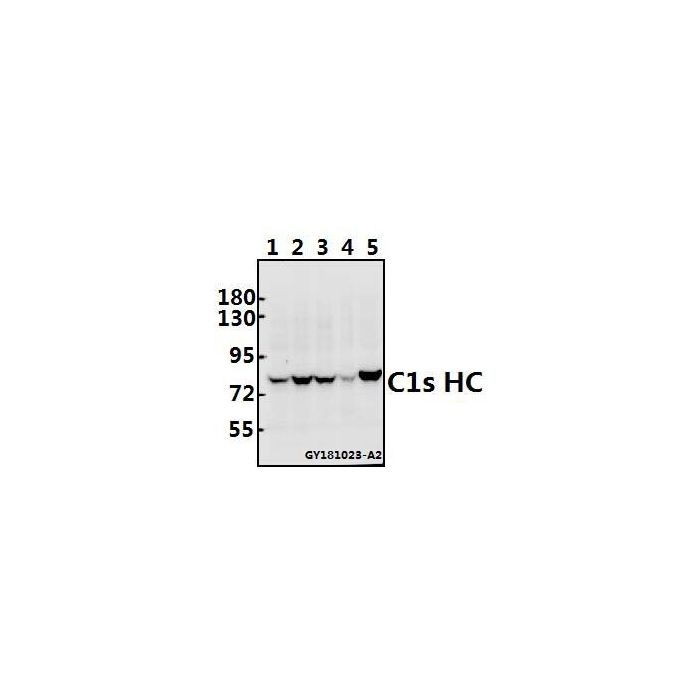C1s HC (R437) polyclonal, anti-human, mouse, rat
€305.00
In stock
SKU
BS7031
Catalog Number: BS7031
Size: 100 µl
Other Size: 50 µl
Isotype: rabbit IgG
Applications: WB
Questions? Contact us!
Size: 100 µl
Other Size: 50 µl
Isotype: rabbit IgG
Applications: WB
Questions? Contact us!
Background:
The complement component proteins, C1, C3, C4, and C5, are potent anaphylatoxins that are released during complement activation. Binding of these proteins to their respective G protein-coupled receptors induces proinflammatory events, such as cellular degranulation, smooth muscle contraction, arachidonic acid metabolism, cytokine release, leukocyte activation and cellular chemotaxis. C1q, together with proenzymes C1r and C1s, yield C1, the first component of the classical pathway of the serum complement system. C1 consists of a calcium dependent trimolecular complex of C1r, C1s and C1q in a 2:2:1 ratio. Activated C1s is in the form of a disulfide-linked heterodimer consisting of a heavy chain and a light chain. Defects in the gene encoding for C1s can cause selective C1s deficiency, a disorder characterized by early onset of various autoimmune diseases.
Alternative Name:
TBC1 domain family member 4, Akt substrate of 160 kDa, AS160, TBC1D4, AS160, KIAA0603
Application Dilution:
WB: 1:500~1:1000
Specificity: Aiolos (S386) polyclonal antibody detects endogenous levels of C1s HC (R437) protein.
Immunogen:
Recombinant full length Human TBC1D4.
MW: ~ 76 kDa
Swiss-Prot: P09871
Purification & Purity:
The antibody was affinity-purified from rabbit antiserum by affinity-chromatography using epitope-specific immunogen and the purity is > 95% (by SDS-PAGE).
Format:
Rabbit IgG, 1mg/ml in PBS with 0.02% sodium azide, 50% glycerol, pH7.2
Storage:
Store at 4°C short term. Aliquot and store at -20°C long term. Avoid freeze-thaw cycles.
For research use only, not for use in diagnostic procedure.
The complement component proteins, C1, C3, C4, and C5, are potent anaphylatoxins that are released during complement activation. Binding of these proteins to their respective G protein-coupled receptors induces proinflammatory events, such as cellular degranulation, smooth muscle contraction, arachidonic acid metabolism, cytokine release, leukocyte activation and cellular chemotaxis. C1q, together with proenzymes C1r and C1s, yield C1, the first component of the classical pathway of the serum complement system. C1 consists of a calcium dependent trimolecular complex of C1r, C1s and C1q in a 2:2:1 ratio. Activated C1s is in the form of a disulfide-linked heterodimer consisting of a heavy chain and a light chain. Defects in the gene encoding for C1s can cause selective C1s deficiency, a disorder characterized by early onset of various autoimmune diseases.
Alternative Name:
TBC1 domain family member 4, Akt substrate of 160 kDa, AS160, TBC1D4, AS160, KIAA0603
Application Dilution:
WB: 1:500~1:1000
Specificity: Aiolos (S386) polyclonal antibody detects endogenous levels of C1s HC (R437) protein.
Immunogen:
Recombinant full length Human TBC1D4.
MW: ~ 76 kDa
Swiss-Prot: P09871
Purification & Purity:
The antibody was affinity-purified from rabbit antiserum by affinity-chromatography using epitope-specific immunogen and the purity is > 95% (by SDS-PAGE).
Format:
Rabbit IgG, 1mg/ml in PBS with 0.02% sodium azide, 50% glycerol, pH7.2
Storage:
Store at 4°C short term. Aliquot and store at -20°C long term. Avoid freeze-thaw cycles.
For research use only, not for use in diagnostic procedure.
| Is Featured? | No |
|---|
Write Your Own Review

